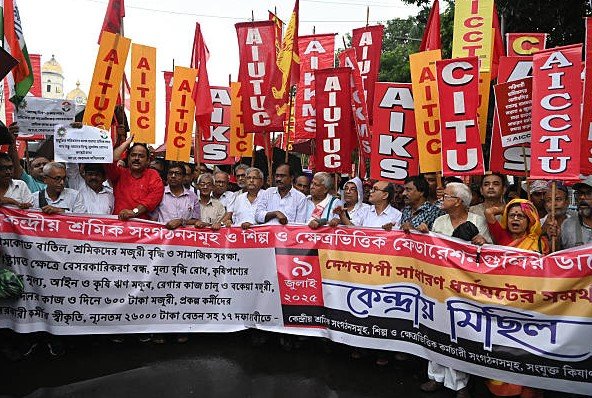Over 250 million workers expected to join strike against job insecurity, labor laws, and pro-business policies
A massive national strike called by ten major trade unions has jolted India today, with sweeping protests disrupting services from buses to banks. The call for Bharat Bandh—backed by both urban workers and rural laborers—centers on fears that the government’s economic policies are sidelining ordinary citizens in favor of corporations.
With participation reportedly crossing 25 crore (250 million), it’s shaping up to be one of the biggest nationwide shutdowns in years.
Trains stalled, roads blocked, tempers rising
Delhi, Mumbai, Kolkata—no corner of the country was untouched. Major junctions turned into protest zones, and morning commuters found themselves stuck as autos disappeared and buses stayed off roads.
Train services too were affected in pockets. In West Bengal, rail tracks were briefly blocked by demonstrators. Meanwhile in Kerala, government employees boycotted work in solidarity.
In some places, people were stranded for hours. In others, protesters clashed with police.
Some looked worried. Others angry.

What’s this really about?
At the heart of the protest lies a boiling pot of grievances.
The unions are angry. But it’s not just about wages. It’s about how the government’s handling jobs, who gets them, and who’s being left out. Young Indians are particularly miffed—especially those in their 20s who say they feel invisible to policymakers.
Trade union leaders say ministries are quietly bringing back retired bureaucrats instead of hiring fresh graduates.
And this isn’t happening in just one department:
-
Indian Railways: Several top positions reportedly offered to retirees
-
NMDC Ltd and steel units: Temporary rehires of ex-staff over new recruits
-
Public universities: Delays in faculty recruitment despite long-pending vacancies
“You have an entire generation ready to work, and they’re handing out jobs to people already retired? That’s just cruel,” said Devika Sinha, a 24-year-old engineering graduate protesting outside Delhi’s Connaught Place.
Who’s striking and why does it matter?
This isn’t your average one-day symbolic protest. It’s a coordinated effort by ten powerful central trade unions—including INTUC, AITUC, CITU, and HMS—joined by sectoral groups like AIKS (farmers) and MNREGA worker collectives.
The issues at hand:
-
Scrapping of new labor codes that unions say erode worker protections
-
Demand for minimum wage increase across both organized and unorganized sectors
-
Opposition to privatization of government services and public enterprises
Here’s a quick overview of the major unions and their affiliations:
| Union Name | Political Backing | Sector Presence |
|---|---|---|
| INTUC | Indian National Congress | PSU, Railways, Telecom |
| CITU | CPI(M) | Manufacturing, Construction |
| AITUC | CPI | Banks, Insurance |
| HMS | Independent | Transport, Health |
Many of these groups have long-standing clout. When they coordinate like this, the impact can stretch from city offices to village farms.
Scenes from the ground: anger, banners, and simmering distrust
In Kolkata, workers held placards that read “Stop Selling India” and chanted slogans against labor reforms.
In Bengaluru’s Peenya industrial area, factories remained shut as small-scale workers joined in.
In Patna, tractor rallies by farmer unions drew attention to rural distress. Some had traveled for hours—on foot or by shared jeeps—to join in.
You could feel the frustration in the air.
“We didn’t come here for fun,” said Umesh Paswan, a contract worker from Bihar. “No job security. No pension. Now they want to take away even what little we have?”
Not just a workers’ issue anymore
Interestingly, today’s protest wasn’t limited to factory floors and union halls. School teachers, students, public health workers, even gig workers—many showed up.
And that’s perhaps what makes this bandh feel different. The discontent has spilled beyond labor corridors. It’s become a national mood.
One 19-year-old nursing student in Hyderabad, Raji Sharma, summed it up bluntly: “Everyone’s talking about startups and unicorns, but basic jobs aren’t even there. Where do we go?”
Government’s silence adds fuel
So far, there’s been little official response beyond tight security deployment and cautionary advisories.
No major minister has commented on the strike. No open talks have been offered.
That silence hasn’t gone unnoticed.
Union leaders say they’ve written letters, requested meetings, and submitted memorandums for months—but have been met with indifference.
CITU’s general secretary, Tapan Sen, called the government’s attitude “arrogant and detached.”
Services hit: what’s open, what’s not
The strike has hit different states in different ways. Some have seen full shutdowns, others limited disruptions.
-
Kerala and West Bengal: Near-total response; state buses off roads
-
Punjab, Tamil Nadu: Partial impact; some banks and offices closed
-
Delhi and Mumbai: Mixed reactions; autos and metro running but with reduced footfall
Banks in public sector domains remained closed in several areas, affecting cash withdrawals and government transactions. Meanwhile, MNREGA work in some villages came to a halt as daily-wage laborers joined rallies.
What next?
Unions have warned that if their demands continue to be ignored, today’s bandh could just be the beginning. Some are already hinting at sector-specific strikes next month.
A few insiders even spoke about the possibility of a “week-long coordinated shutdown” if talks remain stalled.
